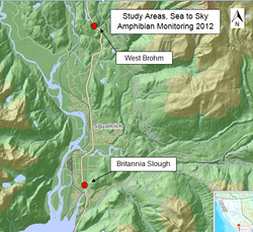West Brohm Lake Wetlands Compensation Project in Partnership with BC Wildlife Federation (BCWF) - Wetland Institute Program
Funding support:
Ministry of Transportation and Ministry of Environment
|
|
Project Background
|
In preparation for the 2010 Winter Olympics, the Highway 99/Sea to Skyunderwent major upgrades including a 1.9 km realignment of Pinecrest Estates that required infilling of several wetlands. This wetland complex provided habitat for six aquatic breeding amphibians including the Red-legged Frog (Rana aurora), which is a Schedule 1 species of special concern on the federal Species at Risk act, and a Blue listed species of concern on under the BC Wildlife Act.
Through the highway realignment, both permanent and ephemeral wetlands were lost and 1037 amphibians, including 683 Red-Legged frogs, had to be salvaged. To compensate for these impacts, the Ministry of Transportation provided funding to the Ministry of Environment to facilitate habitat restoration to benefit Red-legged frogs. The SRWS had done previous bio-inventory work for the Highway 99/Sea to Sky improvement project and in 2011 the Ministry of Environment retained the SRWS to carry out the wetland restoration project. |
Site Location
South of Brohm Lake and adjacent to West Brohm Creek. The wetlands were created on an old Highway 99/Sea to Sky road bed.
Objectives
To build three wetlands for amphibians, including the blue-listed Red-legged Frog, in compensation for wetlands lost through the Highway 99 upgrades.
Works Completed
Three discrete ponds, all roughly 80 m² when full, were dug into the old Highway 99 roadbed. Set out in a line, the ponds parallel West Brohm Creek. Ponds were designed to be shallow (less than 1 m) and ephemeral, were lined with layers of geotextile, and received a top dressing of sand. Liners make the ponds watertight and thus water levels are a function of rainfall and evaporation only. Natural leaf litter and small woody debris were distributed around and in the ponds, and straw and grass seed mix were applied around the riparian perimeters.
Post-restoration Monitoring
After only one year the wetlands were already showing signs of amphibian life, providing habitat to species at risk. In our 2012 habitat monitoring, Red-legged Frogs were the only species observed at West Brohm site, no egg masses were observed but 5 adults were seen.
Media
|
In the short video featured below, SRWS Executive Director Edith Tobe shares the story of the West Brohm Wetland with the BC Wildlife Federation, who through their Wetlands Institute Program, partnered with the SRWS on this amphibian wetland project.
|
|

